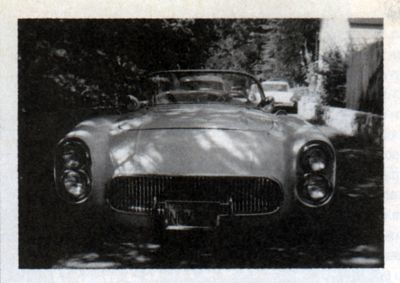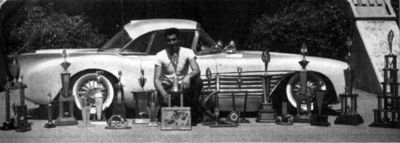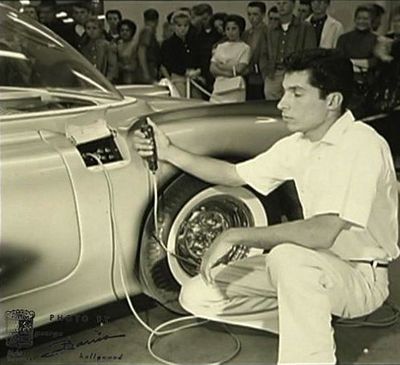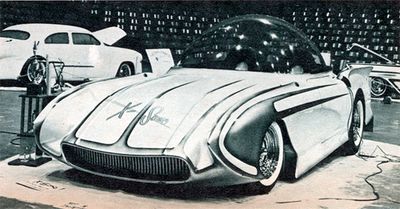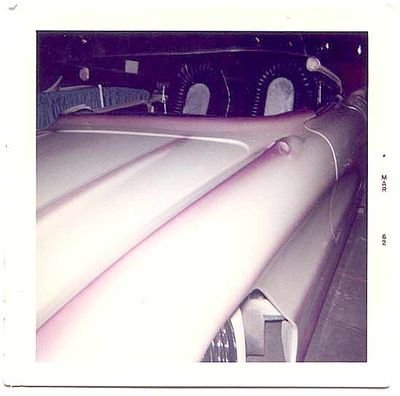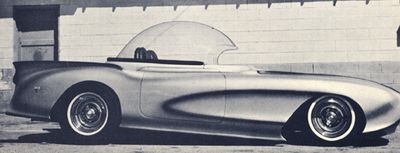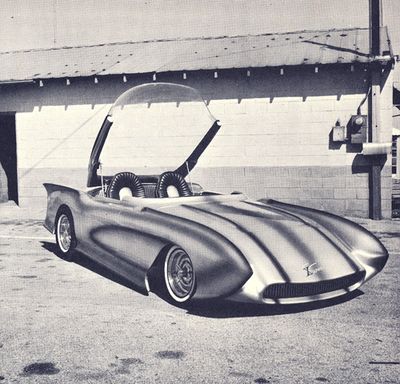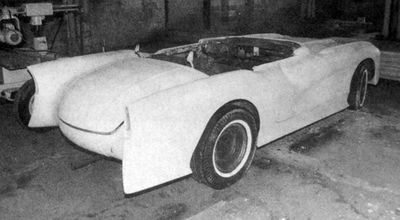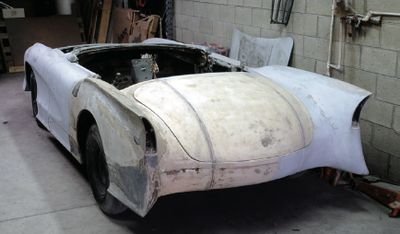Ron Aguirre's 1956 Chevrolet Corvette - The X-Sonic
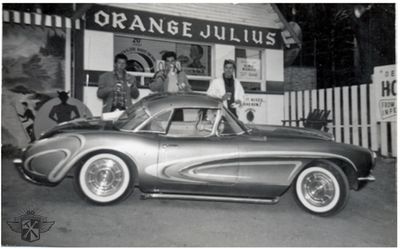


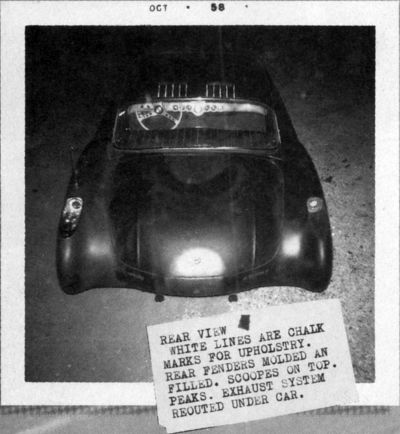







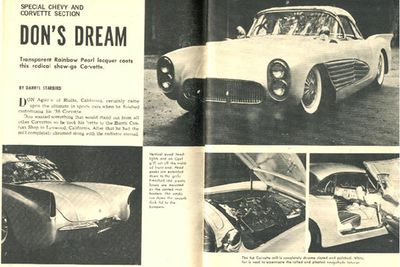



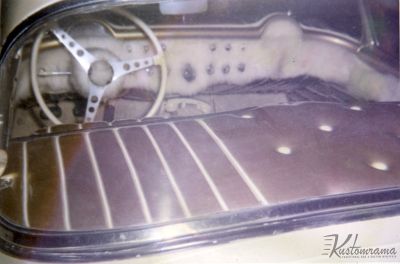




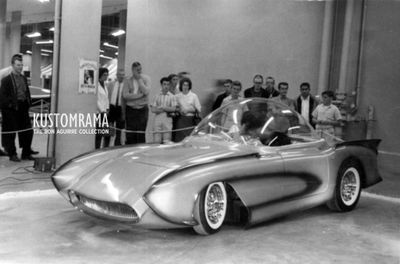


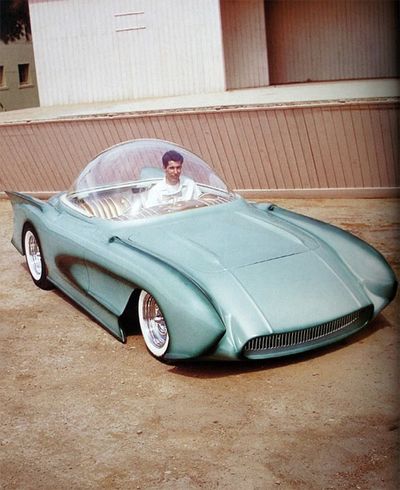








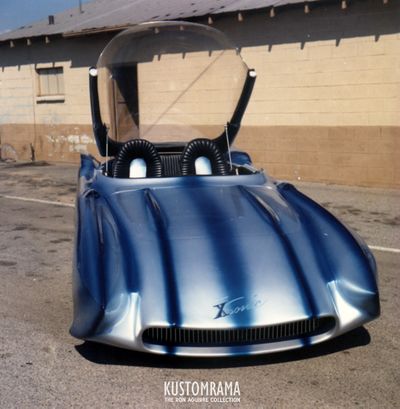




1956 Chevrolet Corvette owned, designed and fabricated by Krankers of San Bernardino member and President Ron Aguirre of Rialto, California. Ron's wild custom Corvette, known as the X-Sonic, was for many year acknowledged as the first car ever using hydraulics to raise and lower the front suspension.
Ron bought the metallic brown Corvette brand new in 1957. Right after he got it, the car was lowered a bit by cutting the coils up front and by installing wooden blocks in the back. Side pipes were also installed to give the car an even lower appearance. After the car had bee lowered, Ron took the Corvette to Ed Roth at The Crazy Painters for a wild scallop and flame paint job.[6] This version was later lowered down to a one-inch clearance and fit with custom hubcaps made from Dodge caps and Edsel three-bar spinners.[1]
In 2019 Hilton Vail, an old buddy of Ron and a fellow Krankers member, told Sondre Kvipt of Kustomrama that he believes Ron's Corvette came with a 4-speed transmission; "He took the standard transmission out, and installed a transmission from a 1957 Chevrolet in it. In 1957 Chevrolet came out with an automatic transmission that you never felt shift. Unless you ordered otherwise, it came with the car if you ordered a fuel-injected 283 engine in your Bel Air. Ron found out that you could start the car in that automatic transmission, whip it in gear, and it wouldn't just take off unless you gave it some throttle."
In 1957 a law was past by Gov. Brown against lowered cars. The law that was named the California Vehicle Code 24008 wasn't being enforced until 1958. The law outlawed any car having any part of the car lower than the bottom of its wheel rim. Having the lowest car in Rialto, a local cop named Lester Groves made his #1 priority to give Ron tickets for being too low. This really bugged Ron, so after visiting a friends body shop seeing a bodyman pushing a dent out with a hydraullic Port-A-Power tool, Ron started to think. He looked at the ram and instantly got the idea to put this unit between the spring and frame to lift his car. Ron explained the idea to his dad Louie, who was a welder by trade. Louie started to make the cups Ron had designed to hold the rams. Ron had hoses made that would extend into the car, and he set the hand pump on the hump between the seats.[7] Within three months after Ron had bought the car he had installed the first of what was to be many versions of a hydraulic system in the car.[6] In a mail correspondence with a member of the LayItLow Forum Ron explained his first experience with the newly designed hydraulic suspension, and his first meeting with Lester Groves, nicknamed "Sandy", driving the car: "But it wasn't until 1959 that I was able to raise a lot of Hell with the system the way it was and I was going to drive "Sandy" THE COP crazy. We waited for him to ride his bike to his spot across the street from the local hangout in Berdo "Ruby's Drive-in". I was parked on the lot with my car lowered way down. There were about 100 of my school friends at the drive-in waiting to see what would happen. I left the car down and started to drive out and the side pipes were scraping the pavement (It was way cool to have your car dragging on the pavement). I had my girlfriend get out and my buddy got in with the instructions to pump hard on the handle of the pump as soon as I gave him the word. Well, knowing "Sandy" was across the street and waiting for me to leave the restaurant so he could give me a ticket in front of all my friends and teach them that this punk was not going to get away with breaking the law, again. I pulled out onto the street and watched Sandy start his bike, I told my buddy to start pumping. I didn't get twenty feet and Sandy had his red lights on me. I got out of the car and everyone from the drive-in was standing on the sidewalk. I greeted "Sandy" by name, as no one called him Sandy to his face - "Hi, Lester what seems to be the problem"? He stated "You know your car's too low". "But Lester", I said," it isn't too low any more, I took your advise and raised it to legal height". He smiled at me and took his ticket book. Back then, this is how the cops checked cars if their ticket book did not pass freely under your car you would get a ticket, and he slid it under my car without hitting anything. Boy, was his face red and with all the witnesses yelling and screaming, he didn't say a word, he gave me a confused look and got on his bike and left. OH... revenge was so sweet....."" The hand-pump system was cumbersome and it didn't raise the car evenly. Ron's father knew about an aircraft surplus place south of Los Angeles called Palleys. They went down there, and began to talk to people about the problem and how to solve it. He bought 12-volt and 24-volt pumps and different types of cylinder lines and equalizers to equalize the pressure. This was done over a period of time, but Ron and Louie eventually got the system to move the car up and down smoothly and easily by just pushing a button.[6]
Filbert Aguirre, Ron's younger brother, played a significant yet often overlooked role in the development of the X-Sonic's hydraulic system. Filbert was responsible for much of the electrical work and helped install the hydraulic systems on the car. He also built the first documented wired hydraulic remote switch for a custom car, which became a game-changer for the lowrider scene. Filbert's contributions extended to creating one of the earliest under-dash hydraulic switch panels, showcasing his innovative approach to customizing vehicles. His technical skills and creativity were essential to the X-Sonic's evolution.[8]
In 1958, Ron started to modify the fiberglass body. The front end was restyled by extending the fenders and by installing vertical quad headlights from a 1958 Dodge. The headlights were backed by a gold glitter-finished panel. All unnecessary chrome, including the door handles were shaved away. Solenoids were installed to operate the doors after shaving the handles. The stock grille was removed and the grille from a German Opel was shaped to fit the opening.[9] The rear end was given a winged appearance by adding flared fiberglass fins hand made by Ron. Custom made plastic lenses were made to fit the fins. The exhaust holes in the fenders were filled for a smoother rear end. Two raised and molded ribs were built up on the glass with epoxy resin. The ribs ran the entire length of the body. On the top, Ron added two Impala-type six-inch molded airscoops. A Honey Gold themed Naugahyde tuck-and-roll was filled in the scoops and also in the stock Corvette insets along the sides of the car. The interior was also done in gold Naugahyde with white beads and buttons, trimmed in white acrilian fur. All of the upholstery was done by Tom Sterkel. Two Appleton spotlights wrapped up the style.[10] Photos dated October 1958 shows the car in the middle of the restyling process. By then the car still had the stock taillights, but it had been fit with an Opel grille and the beads had been molded to the front and rear end. According to an interview Pat Ganahl did with Ron for a featured story in The Rodder's Journal 50 the hydraulics were also installed by this time. The first time Ron used the hydraulics at a car show, was at the first annual Custom Car Spectacle held May 30 - 31, 1959 by the Cut-Outs of Long Beach at the Veterans Stadium in Long Beach, California. There was a concrete barrier around the track that had to be cleared to get your car onto the track. All of the car owners had to block their cars up on wood to clear the barrier except Ron. Ron drove his car up to the barrier, pushed the button to raise the car and drove it over the concrete. People attending the show were blown away seeing Ron's Corvette, and it didn't take long time before everyone wanted hydraulics.[6] "We were 17 Krankers cars going to that show," Hilton Vail told Sondre Kvipt, "and I happened to be the second car in line behind Ron in the Corvette. A highway patrolman on a motorcycle saw his car down low, so he turned around and came back. I honked my horn at Ron to get his attention so he could raise the car up. When the highway patrolman came to the front, where Ron was at, the car was up, but they guy still pulled him over, so we all stopped together. The highway patrolman said, "I would have sworn coming at you that your car was illegally low." Ron's story was; "You know, that has happened more than once. I don't know why it looks that way when it's going down the road, but it is not illegally low." Ron then told the higway patrolman to walk back across the road at an angle, and stand and look at the car again. So Ron lowered the car down. He raised before the higway patrolman returned and he told Ron "Yeah you're right. I would have sworn that car was too low. I don't understand why it does that"."[11]
September 5, 1959 the restyled version of the X-Sonic was shown at the first and last Disneyland Car Club Day and Autocade. This version featured a red and gold panel paint job by Ed Roth. A silver-white Rainbow pearl had been used as base for the custom paneling job.[10] As Ron wasn't satisfied with the paint job, this version only lasted that one day.[3] The next version was much simpler, as the whole car was given a "Rainbow Pearl" paint job by Larry Watson at Watson's House of Style.[12] At the Disneyland Car Club Day and Autocade Show, Ron's Corvette was powered by the stock 245 engine. Fit with two four barrel carburetors, the stock engine had taken some six trophies at the drags i addition to several show trophies.[10] The stock engine was later replaced by a completely chromed and polished 327 Chevrolet V8 equipped with Thompson forged pistons and a reworked Duntov camshaft.
A month later, October 2, 1959, Ron attended a one day car show held by the Deacons car club in Ron's hometown of Rialto. Photos from the show shows the car all done "Rainbow Pearl" without the top running hubcaps with bullets in the centre.[1] The rainbow pearl finish was achieved by using a variety of colors for the under base, topped off with a translucent pearl coat.
A couple of months later, November 26 - 29, 1959, Ron showed the Corvette at the Bakersfield Motor & Boat Show at the Kern County Fair Grounds. On a photo from the show published in Custom Cars July 1960, you can see that Ron in the beginning named his car the "Exsonic" instead of the "X-Sonic". [13] This version featured a set of rare finned bolt-on aluminum hubcaps designed and cast by Bill Brown of Rialto. The hubcaps were designed to cool the wheels and brake drums. Only a handful of these sets were made.[1] February 22 - 28, 1960, this version was also shown at the 12th National Roadster Show in Oakland, and according to a story published in Motor Trend June 1960, Ron's Corvette, Bob Yoas' 1957 Chevrolet Corvette and Ron Rodden's 1957 Chevrolet Corvette were the striking highlight of the whole show.[14] Darryl Starbird wrote a featured story on this version of the X-Sonic for one of the current custom magazines. In the story Darryl states that the X-Sonic was restyled by Barris Kustoms, and that the owner of the car was "Don Aguirre". According to Ron, George Barris and Barris Kustoms never had anything to do with the X-Sonic.[15]
Contents
Fins and Tunneled Headlights
November 16 - 20, 1960 the X-Sonic was shown at the 1960 Tridents Rod Custom Autorama in the Pasadena Civic Auditorium. By then the tuck and roll Naugahyde had been removed from the body-sides of the car. The car had also been modified by tunneling the headlights and adding fins to the lower parts of the front and rear fenders.
The Bubble Top Version
Ron and Ed Roth were good friends, and by 1960 they decided that they wanted to build "Feature" cars and get paid to show them, not just win trophies. Ron wanted to go futuristic, and he wanted to replace the stock top with a plastic bubble top. He tried using airplane canopies from aircraft surplus yards first, but they were cracked and split and foggy, and they weren't the right shape. Ron had previously made a set of red bubble taillight lenses for the X-Sonic by clamping heated plastic between two pieces of plywood. The top one had been cut out to the perimeter shape, and by blowing air through a hole in the lower piece the taillights had taken the right shape. These were done at House of Plastics in San Bernardino, but as the House of Plastics didn't have a big enough oven for the top, he found a place in El Monte that had a big enough oven. He made a big plywood platform, and put a tube in the middle with an air chuck and a shut-off valve. Ron's father had made a metal ring to Ron's pattern for the top. Armed with 40 to 50 C-clamps, and seven or eight assistants the plastic was heated in the oven. It was put on the base before the ring was put over and the plastic clamped down. After clamping it down, Ron started to pump air into it, a little at a time until he got the height he wanted. He then shut the air valve to keep it there until it cooled. Thanks to good planning and preparation the top was done at the first try. After Ron had explained how he made his top, Ed had a bubble top installed on his next creation the Beatnik Bandit.[16] The first bubble top version of the car was painted by Larry Watson at Watson's House of Style, and it featured Larry's first fade paint job.
April 18-32, 1961 the car was shown at the Tridents Rod Custom Autorama with the bubble top. A month later Ed Roth photographed it for Rod & Custom Magazine, and June 9 - 12, 1961 it was displayed at the second annual rod and custom show held by the New Mexico Timing Association and the New Mexico Rod and Custom Association in Albuqureque, New Mexico. Both Ron and Ed Roth were judges at the show, and Ed had the Beatnik Bandit displayed at the same show. Geogre Bender was the manager of the show.[17] February 16-18, 1962, the X-Sonic was displayed at another show managed by Gene Bender, the third annual Tucson Rod & Custom Auto Show. The X-Sonic was one of the main attractions along with Ed Roth's Rotar.[18]
In the summer of 1961 Pat Ganahl remembers seeing the first bubble top version of the X-Sonic on a car show.[1] This version had gone through radical changes. The dual headlights were gone and the nose had been peaked and extended 12". The headlights were hidden behind a homemade fiberglass grille shell filled with thirty-eight vertical grille teeth. In the rear, the car had been modified with sharply peaked fenders and bubble blown taillights. It was painted in a blended aqua pearl made from the scales of 10,000 Scandinavian fish! Fading was pas painted around the side sculpturing. The cast aluminum hubcaps had been swapped for a set of chromed and reversed 14" wheels that Appliance Plating in Gardena had made for Ron. This version of the car still featured the original seats done in gold Naugahyde when it was first shown. A console was located between the front seats, the console contained remote-control buttons that operated the steering, doors, bubble top, ignition, lights, and front suspension ground clearance. The X-Sonic used and electric motor operated by a toggle-switch to steer, and Ron points out that it was hard to drive on the freeway. An elaborate panel of receivers and relays operated these components through a radio control unit plugged to a socket inside the gas filler door. For shows, a recorder provided narrative sounds. Entry from the outside, by raising and lowing the bubble top, was operated through pushbuttons found under the gas filler flap. After the bubble top and electrical steering were installed, Ron didn't cruise the car at the streets much anymore as it was too hot and too hard to steer.
The X-Sonic was later featured on the cover Custom Rodder January 1963. By then, the car had been painted white with a light mist of lavender around the edges by Larry Watson. This version of the car did also feature a new interior consisting of a set of lengthy contour seats that Ron had made. The new seats featured pleated black Naugahyde borders and silver Llama skin in the middle. Tom's Top Shop, of San Bernadino did all the stitching. Black Naugahyde was also used on the instrumentless dashboard, doors and kickpanels. Silver fur coating was used on the floor. Knock-off cover caps by Accessories International was used on this version of the car. A picture traced back to March 1962 shows the X-Sonic with the white and lavender paint job applied by Larry Watson of Watson's House of Style. This proves that the white version of the X-Sonic goes all the way back to March 1962.
In Popular Customs Winter Issue 1963 the X-Sonic is shown featuring a platinum pearl paint job with royal and oriental blue shading. In Pat Ganahl's book the American Custom Car, Larry Watson states that he painted the X-Sonic six times as Aguirre kept modifying it. The X-Sonic was the first car ever that Watson painted in metalflake, and according to Larry also the first metalflake job in California. When Larry flaked the car he used gold metalflake that Ron had brought back from New York.[3] "Once buffed the flake looked like it was a mile deep in clear," Ron reminisced. A month later, Watson masterfully overlaid Candy Red, igniting the X-Sonic with fiery depth. Yet, the monochromatic scheme didn't do justice to its contours. Two months later, a pearlescent hue took over, with Watson's artful candy highlights tracing the body's lines, elongating the Corvette's silhouette.Cite error: Closing </ref> missing for <ref> tag After the car had had toured the circuit for a couple of more years the bubble top was in terrible shape, and the paint was really old and bad, so Ron stored the car in his shop for quite a few years before he decided to sell it off.[15]
In the early 1990s Ron heard rumors about a Corvette custom at a Corvette restorer's shop that fit the description of his old creation. The bubbletop, engine, and interior were gone, but the weathered remains sounded a lot like the X-Sonic. Pat Ganahl rushed over, and immediately recognized the car. The car was also missing its grille and taillights, but the full chassis, including most of the hydraulic system was still there. The guy who currently owned it had bought the car from Ron simply as a parts car, not aware of its history. After Pat had explained the car's significance to him, the owner decided not to dismantle it.[3] The car has swapped hands since then, and is currently owned by Emmanuelle Benoit of Upland, California. Emanuelle is a restorer of high end vehicles, and plans to restore the car back to its original splendor. The car is sitting all covered up inside his shop, and Emmanuelle hasn't set a date to begin the project yet.[15]
The Restoration
November 17, 2021 Dave Shuten of Galpin Auto Sports announced that they had acquired the X-Sonic. Shuten also shared that they would share the restoration of the car on The Autopian. Friday, November 19, the car was on display outside the Galpin Hall of Customs at the LA Auto Show.[19]
Magazine Features
Car Craft March 1960
Rodding and Re-styling March 1960
Motor Trend June 1960
Custom Cars July 1960
Twenty Top Customs, by George Barris
Custom Rodder July 1961
Car Craft August 1961
Rod & Custom September 1961
CARS January 1962
Rodding and Re-styling November 1962
Custom Rodder January 1963
Car Craft January 1963
Custom Craft January 1963
Custom Rodder January 1963
Custom Craft November 1963
Popular Customs Winter Issue 1963
Hot Rod Magazine November 1964
Custom Car Yearbook No. 1 1964
Spotlite Book 540 Custom Corvettes
Technical Lowrider Vol 1 No1 1982
Rod & Custom August 1990
Rod & Custom June 1991
Rod & Custom June 1996
Rod & Custom January 2002
Rodder's Journal 50
Kustoms Illustrated Issue 48
References
- ↑ 1.0 1.1 1.2 1.3 1.4 1.5 Rodder's Journal 50
- ↑ 2.0 2.1 The Cardinals Nest
- ↑ 3.0 3.1 3.2 3.3 3.4 Lost Hot Rods
- ↑ 4.0 4.1 4.2 4.3 4.4 www.barriskustomcity.com
- ↑ Rod & Custom Magazine - The 1960s Photo Gallery
- ↑ 6.0 6.1 6.2 6.3 Lowrider Magazine June 1995
- ↑ www.layitlow.com - Interview with Ron Aguirre
- ↑ 46to64
- ↑ Motor Trend June 1960
- ↑ 10.0 10.1 10.2 Car Corner
- ↑ Hilton Vail
- ↑ Watson’s Custom Car Confessions with Cool Chicks and John Law
- ↑ Custom Cars July 1960
- ↑ Motor Trend June 1960
- ↑ 15.0 15.1 15.2 Ron Aguirre
- ↑ Ed "Big Daddy" Roth: His Life, Times, Cars, and Art
- ↑ Albuquerque Journal - June 12, 1961,
- ↑ Tucson Daily Citizen - February 2, 1962
- ↑ Dave Shuten
Sources
Rik Hoving Custom Car Photo Archive
Lowrider Magazine
Jalopy Journal
Motor Trend June 1960
Custom Rodder July 1961
Iowahawk
Twenty Top Customs, by George Barris
Did you enjoy this article?
Kustomrama is an encyclopedia dedicated to preserve, share and protect traditional hot rod and custom car history from all over the world.
- Help us keep history alive. For as little as 2.99 USD a month you can become a monthly supporter. Click here to learn more.
- Subscribe to our free newsletter and receive regular updates and stories from Kustomrama.
- Do you know someone who would enjoy this article? Click here to forward it.
Can you help us make this article better?
Please get in touch with us at mail@kustomrama.com if you have additional information or photos to share about Ron Aguirre's 1956 Chevrolet Corvette - The X-Sonic.
This article was made possible by:
SunTec Auto Glass - Auto Glass Services on Vintage and Classic Cars
Finding a replacement windshield, back or side glass can be a difficult task when restoring your vintage or custom classic car. It doesn't have to be though now with auto glass specialist companies like www.suntecautoglass.com. They can source OEM or OEM-equivalent glass for older makes/models; which will ensure a proper fit every time. Check them out for more details!
Do you want to see your company here? Click here for more info about how you can advertise your business on Kustomrama.

